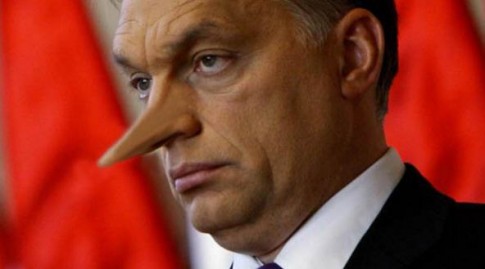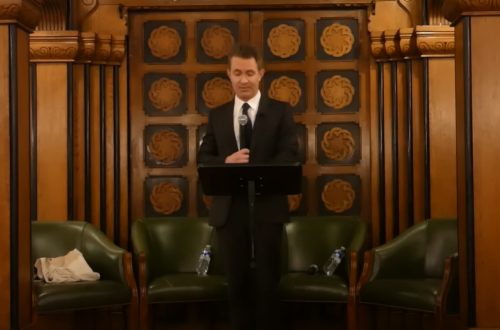Cross-posted from Eva S. Balogh at Hungarian Spectrum
After several false starts, perhaps today I will finally be able to write the real story behind the ill-fated Hóman statue intended to adorn a relatively small square in downtown Székesfehérvár. I wrote at least three times about the controversy over erecting a statue of a politician who had a major role to play in drafting the anti-Jewish laws of the late 1930s even if, in another capacity, he was a well-respected historian. But I didn’t have a full cast of characters, and I didn’t know who was really responsible for coming up with the idea for the statue.
Why do I only now have the opportunity to set the record straight? Because Prime Minister Viktor Orbán did his very best to keep the real story hidden. While foreign papers are reporting the Hungarian prime minister’s categorical stand against erecting a statue honoring a man who collaborated with “Hungary’s oppressors,” the Germans, it was actually Viktor Orbán who masterminded the grandiose plan of erecting three statues in Székesfehérvár, where he went to high school, one of which would depict the anti-Semitic Bálint Hóman. Once the scandal over the statue spread, Orbán tried to cover his tracks. He passed the buck to the locals, who in fact had nothing to do with the project except, at the behest of the central government, lending their names to it.
How did all this come to light? Of course, someone spilled the beans. Gyula Fülöp, the retired director of Fehérvár’s Saint Stephen Museum, was incensed when he read an article in Népszabadság from which he learned that the government was denying any connection to the Hóman statue. It was all a local initiative, János Lázár claimed last Thursday. So, Fülöp decided to speak up. First, he talked to Gábor Czene of Népszabadság and today to György Bolgár of Klubrádió. His revelations are critical in piecing together the story of the Hóman statue.
When did Viktor Orbán decide that he wanted to see a group of three statues on one small square in front of the Cistercian Gymnasium? We don’t know exactly, but the first statue, of Kunó Klebelsberg, the legendary minister of education in the 1920s, was unveiled on November 13, 2013. At that point László L. Simon, undersecretary in charge of cultural affairs in the prime minister’s office, approached Fülöp with the idea of adding two more statues, one of Gyula Kornis, a priest who was a close associate of Klebelsberg, and the second of Bálint Hóman. Fülöp, who is an archaeologist, was unaware of Hóman’s political activities and therefore agreed to “sponsor” the project under the aegis of the Arnold Marosi Alapítvány, named after the first director of the St. Stephen Museum. L. Simon assured Fülöp that there was money for the project. Indeed, soon enough he received a letter from the ministry of justice assuring him of the financing necessary for the two statues. Fülöp still has the letter, but in his conversation with Bolgár he couldn’t recall who signed the letter, although he was pretty certain that it was not Tibor Navracsics, the minister. “Maybe an undersecretary or perhaps a department head,” he said.
A year later, on August 22, 2014, Gyula Kornis’s statue was erected, but Hóman’s had to wait until a Hungarian court decided on his rehabilitation as a war criminal. On March 7, 2015, the court found Hóman not guilty, and the road was thereby open to erect the last statue.
Viktor Orbán immediately moved into action. He had been touring Hungary’s 23 largest cities where he signed “documents of cooperation” in which he pledged all sorts of infrastructure improvements, naturally on EU money. On May 26, 2015 he appeared in Székesfehérvár. Following the signing of the precious document, Orbán delivered a speech in which he said:
The first thing we must remember is that Bálint Hóman, who represented this city in Parliament, was recently fully rehabilitated in legal terms. This also means the rehabilitation of our city, and therefore we hail this decision. I’m glad that Bálint Hóman’s memory will not disappear in the city of Székesfehérvár, and we hope that his scientific as well as his public rehabilitation will also take place.
Indeed, Hóman’s legacy in Fehérvár would be especially vivid if he had a statue to memorialize it.
By that time, the statue was most likely ready, waiting for the day when it could be unveiled. But then came a snag. Gyula Fülöp learned about Hóman’s past and decided that he didn’t want to get involved in this project. He therefore withdrew the Arnold Marosi Alapítvány’s sponsorship. It was at that point that L. Simon, the middleman between Viktor Orbán and the locals, approached the Bálint Hóman Alapítvány to act as a sponsor.

It was most likely during Orbán’s visit to Székesfehérvár that the mayor, András Cser-Palkovics, was told to get the permission of the city council to erect the statue. Cser-Palkovics dutifully delivered.
However, mostly because of pressure coming from the United States, the strategy had to be changed. Again, it was Cser-Palkovics who had to bear the burden and deliver a carefully drafted speech in which he passed responsibility for the project to the Bálint Hóman Alapítvány, with the proviso that if this foundation insists on erecting the statue they are free to do so. This is democracy, he claimed.
This response didn’t satisfy the U.S. officials who had gathered in the Hungarian capital. Robert Berschinski (deputy assistant undersecretary in the Bureau of Democracy, Human Rights, and Labor), Ira Forman (special envoy to monitor and combat anti-Semitism), and Nicholas Dean (special envoy for Holocaust issues) asked the Hungarian government to block the erection of the Hóman statue. These big guns from the U.S. State Department were not satisfied with Cser-Palkovics’s ambiguous statements. They wanted a straight answer from Viktor Orbán himself.
Orbán had to say something because he received a question on the Hóman statue from Ágnes Kunhalmi (MSZP) in parliament. She wanted to know whether, if the civic foundation in Székesfehérvár decides to go through with the project, he would support it or not. Initially he refused to answer the question, but a few minutes later he decided to respond. He said that he couldn’t support the erection of the Hóman statue because the constitution doesn’t allow anyone to be honored who held political office after March 19, 1944, because any political activity after that date meant collaboration with the oppressors, i.e. the Germans. For that reason, he wouldn’t support a statue for Governor Miklós Horthy either. For those who know Hungarian, a video of the exchange is provided.
Just to clarify the historical record, Hóman didn’t really collaborate with the Germans. In fact, he was apparently the only Hungarian politician who paid a visit to Edmund Veesenmayer, the Reich’s plenipotentiary in Hungary, to express his outrage at the occupation. Admittedly, he remained a member of parliament after Ferenc Szálasi became the leader of the country and left Hungary with the retreating German army. His real crime, however, was the role he played in drafting the anti-Jewish laws and his discriminatory legislative activities against Jewish-Hungarians in educational facilities under his care.
As for Viktor Orbán’s role in this affair, foreign papers may hail the fact that at last Viktor Orbán spoke out and distanced himself from the project. Alas, not too many people outside of Hungary will ever know that the real culprit of this sickening story was Viktor Orbán himself.


